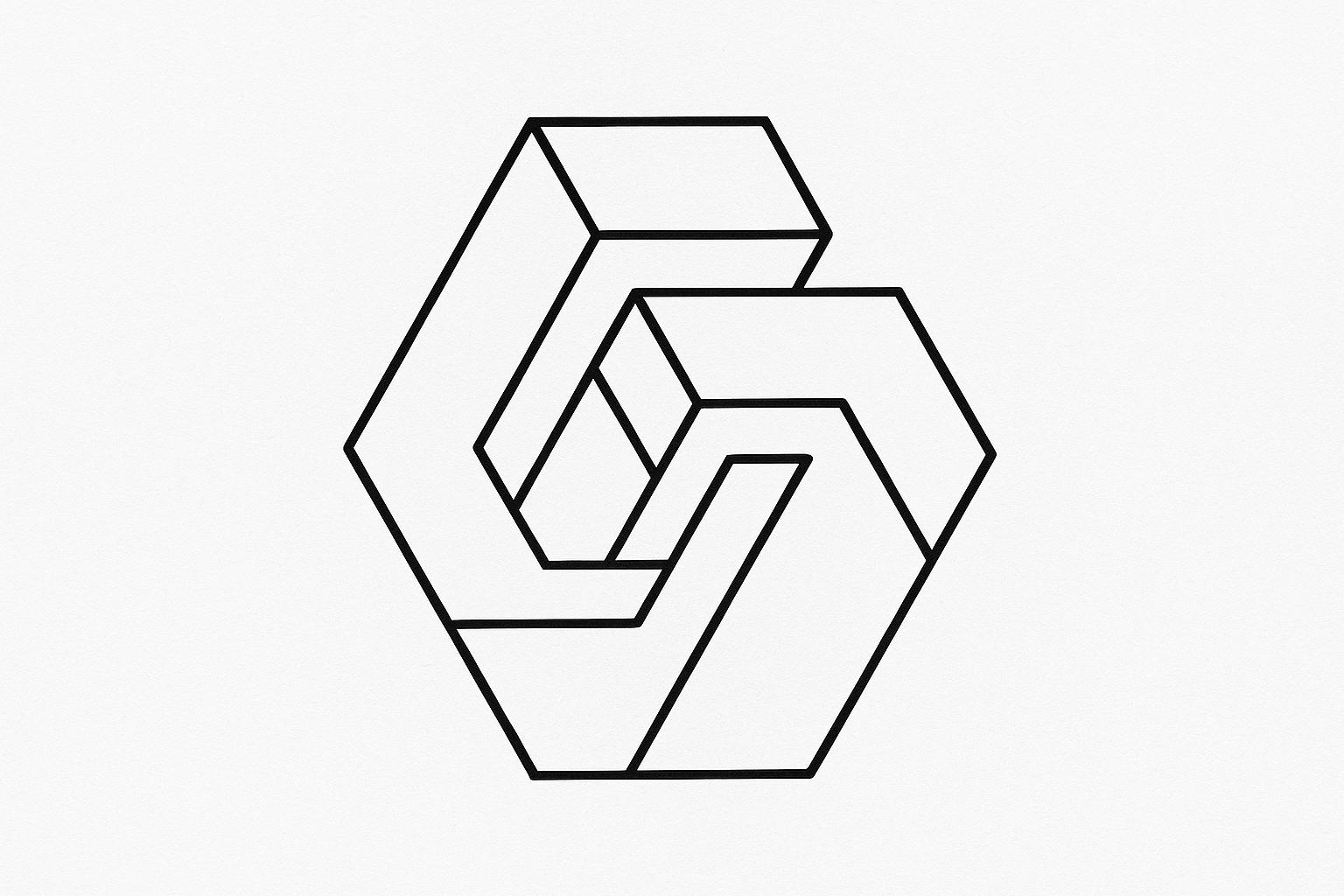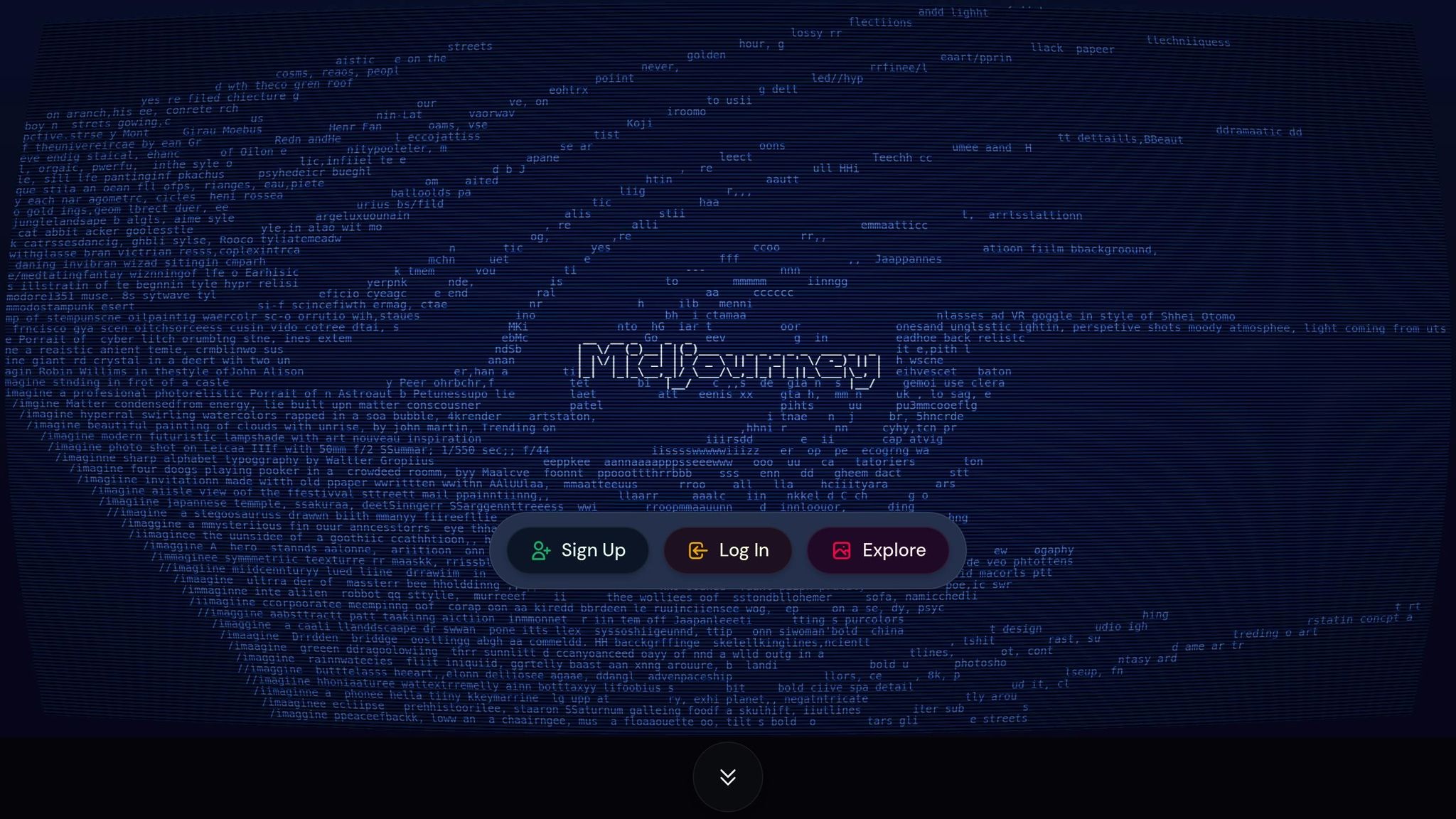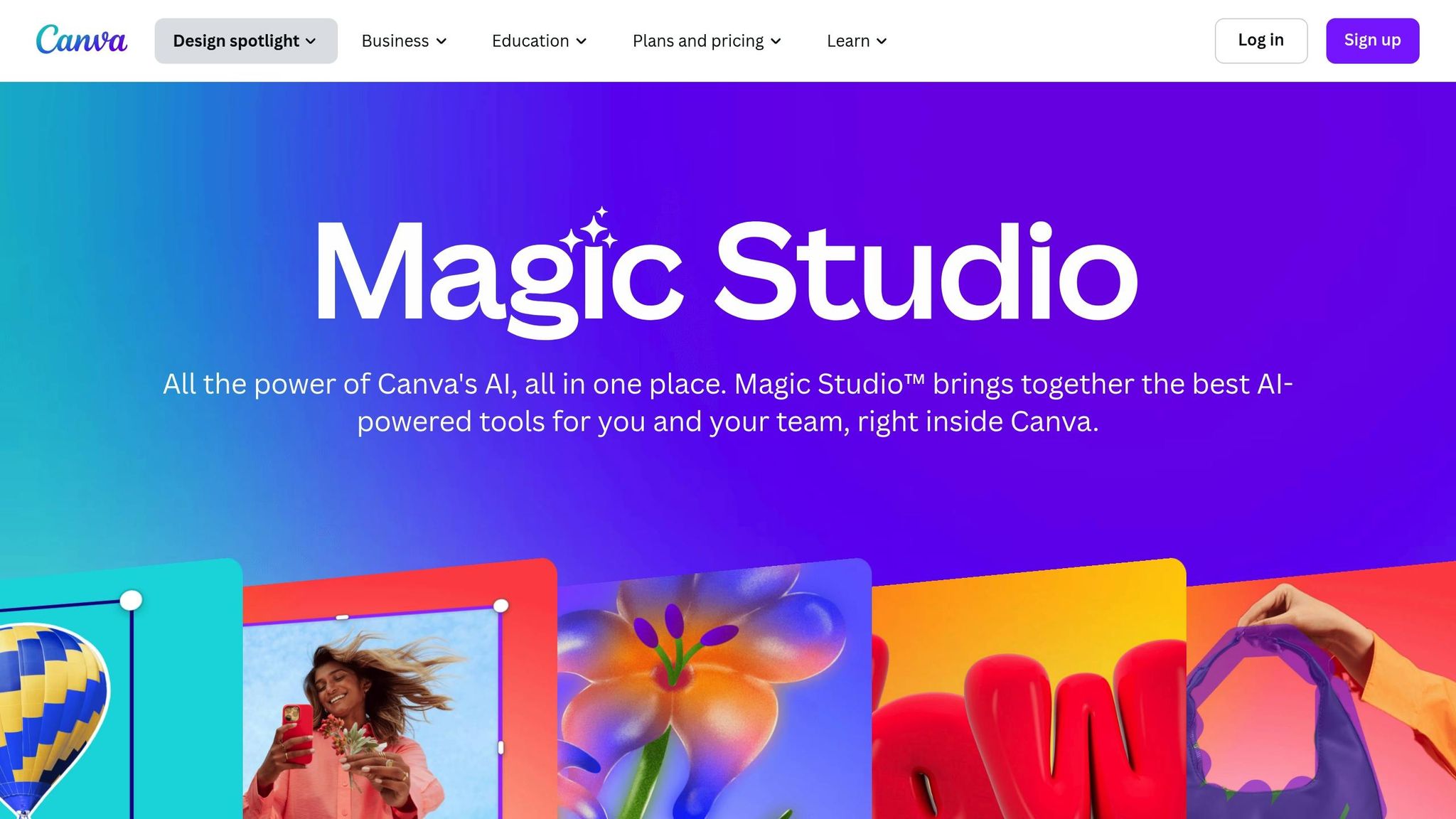
Want to boost your engagement by 400%? These 5 AI-driven strategies for visual content can help you get there. From crafting better prompts to automating design workflows, here's a quick overview of what works:
AI tools like MidJourney and Canva AI make these strategies accessible for businesses of all sizes, helping you create impactful visuals faster and more efficiently. With 73% of marketers already using AI, now’s the time to step up your game.

Mastering AI prompts can transform simple text into stunning visuals. The key lies in understanding how to structure prompts effectively to achieve the best visual results.
An effective AI image prompt includes four key components: image type (e.g., photo, illustration, logo), subject (the main focus), background setting (environment or context), and style (artistic approach or mood). For instance, instead of a vague request like "create a marketing image", try something more specific: "professional photography of a sleek smartphone on a minimalist desk in a modern office with natural lighting." This level of detail guides the AI to produce visuals that align with your vision.
In November 2024, Typeface conducted a comprehensive test of hundreds of AI image prompt variations in real marketing campaigns. The results revealed strategies to create high-quality, on-brand visuals. Typeface offers templates based on these findings, which include detailed prompt structures, style variations, and examples of successful applications. These templates are designed to help generate images that resonate with your audience, whether you're focusing on product photography, lifestyle imagery, or campaign visuals.
For even more inspiration, platforms like Prompt Board provide access to over 2,000 curated AI prompts. These prompts cover a wide range of topics and creative needs. Plus, they can be adapted for use across multiple AI models, including ChatGPT, Gemini, and Claude, making them versatile tools for various generative tasks.
To ensure your visuals align with your brand identity, incorporate specific elements like your brand's colors, fonts, and tone into the prompts. This customization helps maintain consistency across all your creative outputs.
Marketers often rely on A/B testing to identify the most engaging prompt variations. By experimenting with different combinations of prompts and themes, you can refine your approach and develop a distinctive style. This iterative process not only enhances your artistic direction but also broadens the range of visual stories you can create. Mixing and matching prompt elements is a great way to keep elevating your content.

Automation can be a game-changer when it comes to saving time on design tasks. Tools like MidJourney and Canva AI make it possible to create professional-quality visuals in a fraction of the time it used to take.
MidJourney is a powerful tool for generating stunning images tailored to your content needs, whether for articles, blogs, or social media posts. It’s an affordable alternative to pricey stock photos, and it works through text prompts.
With MidJourney, you can craft visuals by using clear, descriptive prompts. You can even refine the results by adding creative tags, assigning weights to elements, or using negative prompts to exclude unwanted features. Once your image is ready, the platform also lets you tweak it further - adjusting aspect ratios, zooming out, extending the image, or swapping out objects.
Pricing starts at $10 per month and goes up to $120, with discounts available for annual plans (ranging from $8 to $96 per month). While MidJourney focuses on producing high-quality images, Canva AI offers a more comprehensive design solution.
Canva AI takes automation to the next level with its Magic Studio, a suite of AI tools designed to simplify the design process.
One standout feature is Magic Media, which enables real-time brainstorming and content creation. For instance, you can generate images of imaginary products or create visuals that are perfect for viral campaigns. In June 2024, Canva introduced video generation powered by Runway’s technology. Imagine using a simple prompt like "A small, cute robot navigating a futuristic cityscape, fantasy" to produce a captivating video - something that was once out of reach for most users.
Other tools, like Magic Edit, make it easy to add, remove, or modify elements in your designs with just a text prompt. The Magic Animate feature brings objects to life with automatic animations, creating eye-catching content. Canva also includes a one-click Background Remover to speed up tasks that used to take hours. And with Magic Design, you can upload a photo or enter a text query, and Canva will generate relevant templates for you - no need to start from scratch.
Canva AI combines design, image creation, and writing into one seamless platform, making it easier than ever to go from idea to finished product. You can generate custom content from a single prompt and refine it all within the same interface, eliminating the need to juggle multiple tools.
Canva Pro costs $12.99 per month or $119.99 annually, offering advanced features like a larger template library, AI tools, and 1TB of cloud storage. For teams, the pricing is $10 per person per month or $100 per person annually, with a minimum of three users.
MidJourney and Canva AI each have their strengths. MidJourney is perfect for creating high-quality, custom images, while Canva AI shines as a versatile, all-in-one design solution. Together, these tools can help marketers and creators streamline their workflow, transforming creative ideas into polished visuals with ease.
Visuals that reflect your audience's interests, values, and experiences are no longer optional - they're essential. With AI tools, creating tailored visuals that truly connect with specific groups has never been easier. These personalized designs can drive engagement and build stronger connections with your audience.
Here’s the deal: fast-growing companies generate 40% more revenue through personalization. When it comes to visuals, this means ditching generic designs and crafting content that resonates on a personal level.
Consider this: 81% of Gen Z buyers and 57% of millennials in the U.S. say personalization influences their purchasing decisions. To capture their attention, your visuals need to reflect their values, aesthetic preferences, and even cultural references. A one-size-fits-all approach just won’t cut it.
Tools like Canva AI and MidJourney shine when you give them detailed instructions. The secret? Be as specific as possible about your audience, style, and context.
For example, instead of asking for a generic "business professional", try a prompt like: "A confident female entrepreneur in her 30s presenting to a diverse tech startup team in a modern co-working space." The more precise your description, the more relevant and impactful your visuals will be.
The foundation of effective visuals lies in understanding your audience. Combine behavioral, demographic, and psychographic data to get a clear picture. Don’t stop at targeting "high spenders." Narrow it down to "high spenders aged 25-35 who engage with sustainability content".
Armed with these insights, you can create visuals that directly address your audience’s interests. For example, if your data highlights a preference for eco-friendly values, your prompts could include natural settings, sustainable products, or green initiatives. This approach ensures your visuals feel relevant and meaningful.
AI tools like Canva AI offer features that make personalization even easier. With Magic Edit and Magic Morph, you can upload reference images that reflect your brand identity and let the AI adapt them for different audience segments. This keeps your visuals consistent while tailoring them to specific groups.
Need captions or text overlays? Magic Write can analyze your brand’s tone and generate copy that feels authentic while speaking directly to your audience. This combination of visual and textual alignment ensures your content hits the mark every time.
When targeting diverse audiences, cultural nuances matter. Your visuals should reflect local customs, language preferences, and even regional social issues. This isn’t just about being polite - it’s about staying relevant.
For instance, if you’re designing content for different countries, adjust your prompts to include culturally appropriate clothing, architecture, or celebrations. These small details can make a big difference in how your content is received.
One of the best things about AI-created visuals is the ability to experiment with multiple variations. Test different prompts and designs to see what resonates most with each audience. Track metrics like engagement rates to fine-tune your approach.
Why does this matter? Because 63% of consumers say they’re annoyed by outdated, generic ads. By testing and optimizing your visuals, you’re not just improving engagement - you’re ensuring your brand stays relevant and avoids the trap of mediocrity. Custom visuals tailored to your audience are the key to standing out in a crowded digital landscape.
Visual storytelling goes beyond just creating appealing images - it's about crafting a narrative that guides your audience seamlessly from start to finish. It’s no surprise that storytelling can increase sales by 30% and boost engagement by an impressive 300%. Pair this with AI’s ability to generate striking visuals, and you’ve got a recipe for capturing your audience’s attention in a whole new way.
Visual narratives do more than just look good - they take viewers on emotional journeys that keep them engaged and inspire action. Articles featuring images, for example, get 94% more views than those without. By weaving a story into your visuals, you create a connection that static images alone can’t achieve. This is where advanced AI tools come into play, helping you design visuals that flow naturally and tell a cohesive story.
AI tools like MidJourney and Canva AI make it easier than ever to bring your visual stories to life. MidJourney specializes in generating intricate, imaginative artwork from simple text prompts, while Canva AI offers tools like Magic Media, Magic Edit, and Magic Animate to refine and structure these visuals into polished narratives.
Take this example: in June 2024, Canva’s Magic Design transformed a simple photo of Honolulu and the title "9 jaw-dropping Hawaii travel itineraries" into fully designed templates for Facebook posts and Instagram stories, all in a "Travel" style. This shows how AI can take a basic idea and turn it into an engaging visual story that resonates with your audience.
In December 2024, MidJourney introduced Patchwork, a tool aimed at collaborative visual storytelling. David Holz from MidJourney describes it as:
"Patchwork is a collaborative, AI-supported infinite canvas for creating fictional worlds. It can help you go from vague story ideas to more complete ones; collaborate with other people to build a coherent setting together; and even assemble unique, collage-like visual stories from little scraps of images and text."
Patchwork enables creators to design interconnected visual worlds, complete with characters, locations, and objects, all working together to tell a unified story. It’s a game-changer for teams looking to build immersive narratives.
The key to successful visual storytelling lies in crafting detailed, precise prompts. Instead of vague requests, include specifics like the type of image, subject, background, style, colors, camera angle, audience, and desired output format.
For instance, if you’re launching a product, you might start with: "Wide-angle shot of excited customers discovering a new tech product in a modern retail environment, bright lighting, documentary style." Then transition to: "Close-up of hands interacting with the product interface, soft focus background, warm lighting." Finally, wrap up with: "Medium shot of a satisfied customer using the product at home, natural lighting, lifestyle photography." These prompts guide AI tools to produce visuals that flow seamlessly from one scene to the next.
AI-driven visual content has been proven to enhance social media engagement by 23–40%. For example, Refresh Digital Strategy used an AI platform to curate 10,000 images into polished storyboards for a client’s social campaign. The result? A 25% boost in engagement and a 15% increase in brand favorability. Similarly, Hedera agency saw a 32% rise in social media engagement for a wellness client by focusing on visuals showcasing facilities and classes over a three-month period.
Custom visuals resonate more when tailored to specific audiences, and AI’s data analysis capabilities make this easier than ever. By analyzing preferences, demographics, and behaviors, AI enables you to align visuals with what your audience truly cares about. This level of personalization ensures your stories connect with different audience segments while staying true to your overall message.
Tanya Slyvkin, Founder & CEO of Whitepage, sums it up perfectly:
"AI tools are eliminating guesswork. They are making it possible to base our storytelling on real, quantifiable insights."
The secret to success lies in constant iteration and testing. Use AI to create multiple variations of your story, measure how they perform, and refine them based on your findings. This process ensures your visual stories not only look great but also deliver real, measurable results.
Building on the strategies for personalized and story-driven visuals, incorporating AI data can take your visual content to the next level. While stunning visuals grab attention, it's the insights from AI analysis that reveal what truly connects with your audience. This approach complements the tailored visuals and storytelling techniques we've already explored.
Here's a fact worth noting: 95% of brands are investing in content optimization, and nearly half of executives (49%) specifically seek personalized content. This isn't just a passing trend - it's quickly becoming a necessity to stay competitive.
AI tools analyze data from various sources to uncover audience preferences and predict which visual content will perform best. By identifying patterns in customer behavior and tracking engagement metrics, AI helps you figure out which visuals are truly hitting the mark.
Companies leveraging AI data for visual content are seeing incredible results. Take Booking.com, for instance. They saved 17 hours of moderation time by using AI to tag TikTok comments. Corning, on the other hand, saw a 124% increase in website visits and cut acquisition costs by 55% thanks to AI-driven strategies.
One standout example is Starbucks. In 2022, they introduced an AI-powered personalization engine called Deep Brew, integrated into their mobile app and rewards program. The results? A 30% boost in ROI and a 15% increase in customer engagement.
When measuring the success of AI-optimized visuals, engagement metrics like social shares and time on page are a good start, but they don't tell the whole story. It's also important to track metrics like brand consistency and conversion rates. For example, compare bounce rates or time spent on pages featuring AI-enhanced visuals to older content. Conversion rates are especially critical - they show whether your visuals are actively supporting your business goals.
The key is to tie these metrics directly to real-world outcomes. This ensures your visual content isn't just eye-catching but also delivers measurable value.
Getting started with AI-driven visual optimization doesn't have to feel overwhelming. Start by assessing your current testing costs and timelines. Many AI platforms offer free tools, like visual grade reports, that can show you what motivates your audience to engage and buy.
Brands like Forever 21 and BCM have seen dramatic improvements using AI for asset production and audience targeting. Some report performance boosts of up to 66%. To achieve similar results, analyze your audience's preferences and use AI to fine-tune visuals - whether it's images, videos, or infographics - that data suggests will resonate most.
This approach allows you to strike a creative balance, where data informs decisions but doesn't stifle artistic vision.
While data is essential for optimizing visuals, creativity remains at the heart of great content. As David Raichman, Creative Director at Ogilvy, puts it:
"AI is a force multiplier for creative expression".
By combining data-driven insights with creative ingenuity, businesses can achieve impressive results. Over 55% of retailers report AI delivering a return on investment of more than 10%. This shows that a thoughtful mix of data and creativity can lead to visuals that not only engage but also convert.
Human oversight is vital, though. It ensures AI-generated visuals remain accurate, ethical, and aligned with your brand's values. By continuously monitoring performance and adjusting based on insights, you can create visuals that consistently drive engagement and conversions. With AI data sharpening your approach, you’re not just creating content - you’re building assets that deliver measurable growth and ROI. And yes, that 400% engagement boost? It’s absolutely within reach.
The five AI-driven visual content strategies discussed here mark a major transformation in how businesses connect with their audiences. By using AI prompt collections, automating workflows, crafting personalized visuals, weaving compelling narratives, and leveraging data to fine-tune strategies, companies can achieve impressive results.
Here’s the proof: AI-powered strategies can deliver 300% higher ROI and cut content production time by 67%. Businesses adopting these methods report 73% higher engagement rates and 45% better conversion rates. Personalization through AI is particularly impactful, driving 89% higher click-through rates and 67% more conversions.
Efficiency is a game-changer too. Implementing AI boosts search rankings by 156%, increases organic traffic by 234%, and helps companies scale content production by an average of 400%.
Kenneth Andrew, General Manager of Microsoft Advertising, highlights this perfectly:
"AI isn't just about efficiency. It's the edge brands need to outperform their competition."
The numbers speak for themselves: integrating AI into your visual content strategy can revolutionize marketing outcomes. Start by selecting the right AI tools for tasks like automation, analytics, personalization, and content generation. Train these tools using your brand guidelines to ensure consistency across all outputs. Remember, AI is most effective as a partner to human creativity, not a replacement.
Regular monitoring and optimization are essential. Keep an eye on your AI tools’ performance and adjust as algorithms and audience preferences evolve. Focus on tracking key metrics like engagement, conversion rates, and ROI to ensure your efforts translate into tangible results.
Here’s a striking fact: as of 2024, 82% of businesses with successful content marketing campaigns use AI. With AI enabling content creation cycles to be 5x faster and boosting production by up to 400%, delaying adoption could mean falling behind.
Now’s the time to act. Whether it’s automating workflows, personalizing visuals, or using data insights, every step you take with AI places you ahead of competitors relying on outdated methods. The tools are ready, the strategies work, and the results are undeniable. Your audience is eager for engaging visual content - AI can help you deliver it.
To keep your brand identity consistent, create AI prompts that explicitly outline your brand's colors, fonts, and visual style. Pull in details from your brand guidelines - like preferred tone or imagery styles - to make sure the visuals match your established look and feel. Clear and detailed prompts make it easier for AI tools to generate content that truly represents your brand.
MidJourney excels at producing artistic and highly detailed visuals with extensive customization capabilities. This makes it a go-to choice for projects that demand unique, intricate artwork. However, access to its features comes with a subscription fee.
On the other hand, Canva AI shines as a beginner-friendly platform, offering a variety of templates and tools to create designs quickly and efficiently. It’s particularly well-suited for team-based and collaborative projects, with both free and paid options available.
If your priority is custom, high-quality artwork, MidJourney is the way to go. For streamlined, team-friendly design tasks or fast visual content creation, Canva AI is the more practical option.
AI is transforming how we approach visual content by bringing in personalization, data-driven insights, and automation. With its help, you can create visuals that align perfectly with your audience's tastes, predict which designs will connect with them the most, and even test ideas in real time to fine-tune your approach. The result? Better engagement, more conversions, and a bigger impact from your content.





